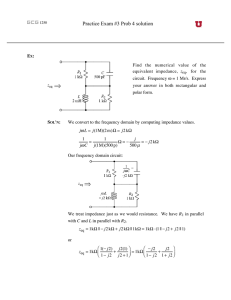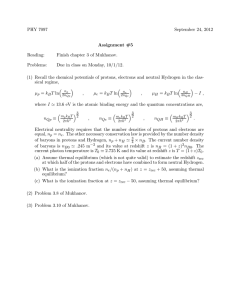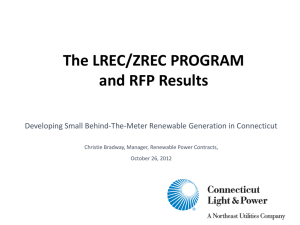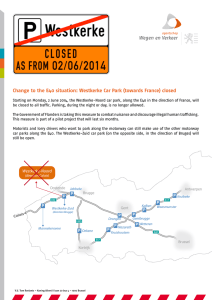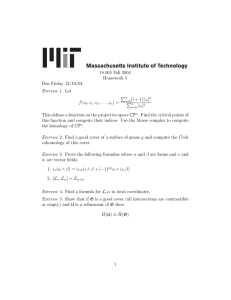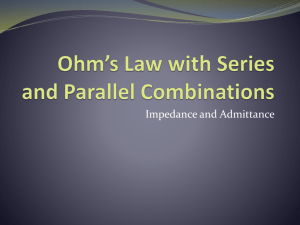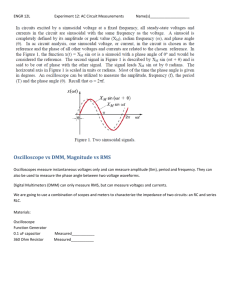Solution 7
advertisement
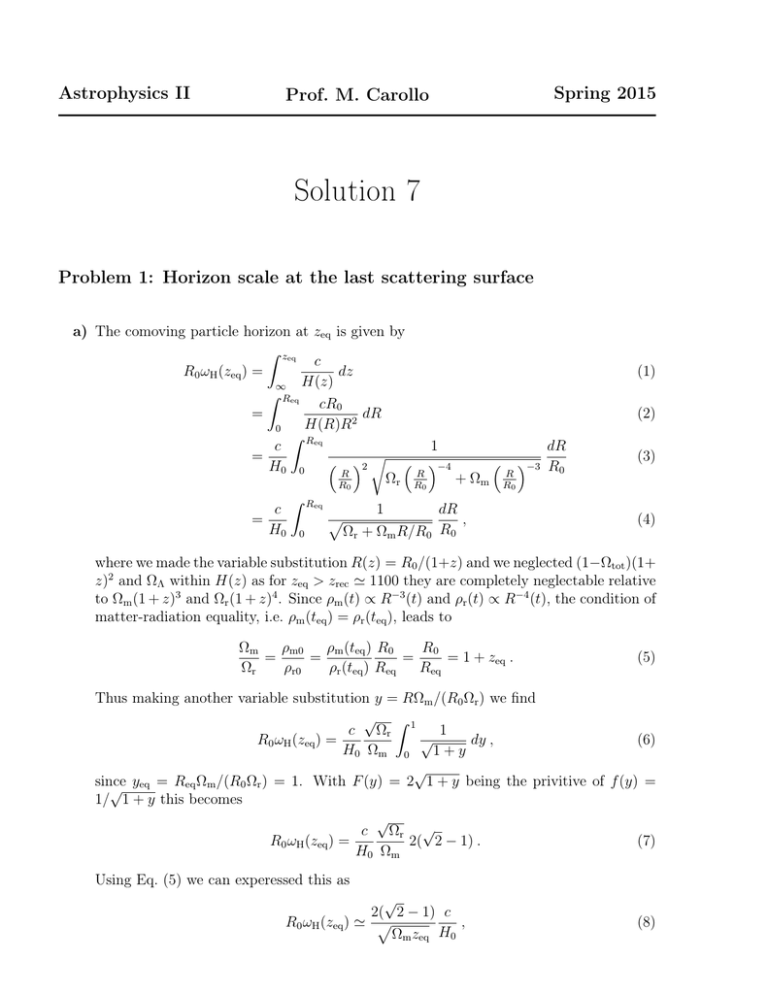
Astrophysics II Prof. M. Carollo Spring 2015 Solution 7 Problem 1: Horizon scale at the last scattering surface a) The comoving particle horizon at zeq is given by Z zeq c R0 ωH (zeq ) = dz H(z) ∞ Z Req cR0 = dR H(R)R2 0 Z Req 1 c dR r = −4 2 −3 R0 H0 0 R R R Ω + Ω r m R0 R0 R0 Z Req 1 c dR p = , H0 0 Ωr + Ωm R/R0 R0 (1) (2) (3) (4) where we made the variable substitution R(z) = R0 /(1+z) and we neglected (1−Ωtot )(1+ z)2 and ΩΛ within H(z) as for zeq > zrec ' 1100 they are completely neglectable relative to Ωm (1 + z)3 and Ωr (1 + z)4 . Since ρm (t) ∝ R−3 (t) and ρr (t) ∝ R−4 (t), the condition of matter-radiation equality, i.e. ρm (teq ) = ρr (teq ), leads to ρm0 ρm (teq ) R0 R0 Ωm = = = = 1 + zeq . Ωr ρr0 ρr (teq ) Req Req (5) Thus making another variable substitution y = RΩm /(R0 Ωr ) we find √ Z c Ωr 1 1 √ R0 ωH (zeq ) = dy , (6) H0 Ωm 0 1+y √ since y = R Ω /(R Ω ) = 1. With F (y) = 2 1 + y being the privitive of f (y) = eq eq m 0 r √ 1/ 1 + y this becomes √ c Ωr √ R0 ωH (zeq ) = 2( 2 − 1) . (7) H0 Ωm Using Eq. (5) we can experessed this as √ 2( 2 − 1) c R0 ωH (zeq ) ' p , Ωm zeq H0 (8) where we set 1 + z ' z as zeq ' Ωm /Ωr ' 3500 (for h = 0.7) is very large. Moreover, for Ωr ' 4.2 · 10−5 h−2 Eq. (7) immediately leads to the numerical expression R0 ωH (zeq ) = 16 Mpc . Ωm h2 (9) b) The comoving particle horizon for zrec can be computed by dividing up the integral as follows: Z Rrec cR0 dR (10) R0 ωH (zrec ) = H(R)R2 0 Z Rrec Z Req cR0 cR0 dR + dR (11) = 2 2 H(R)R Req H(R)R 0 √ Z Rrec cR0 2( 2 − 1) c + = p dR , (12) 2 Ωm zeq H0 Req H(R)R (13) where we inserted Eq. (8) in the last step. To compute the second term in Eq. (12) we make the approximation that the universe is essentially matter dominated for τ > τeq . For a matter dominated universe, the particle horizon at redshift z is given by Z R(z) cR0 dR (14) R0 ΩH (z) = H(R)R2 0 Z R(z) 1 q = cR0 dR (15) 3 0 Ωm RR0 R2 cR0 R(z)H(z) 1+z = 2c H(z) c 1+z p =2 H0 Ωm (1 + z)3 c 1 √ '2 H0 Ωm z =2 (16) (17) (18) (19) for z 1. Thus, we obtain for the second term in Eq. (12) " # Z Rrec cR0 c 1 1 √ dR = 2 −p 2 H0 Ωm zrec Ωm zeq Req H(R)R and the total horizion at zrec becomes " R0 ωH (zrec ) = 2 √ c 1 1 2−2 √ − √ √ H0 Ωm zrec zeq (20) # . (21) For zrec ' 1100 and zeq ' 3500 the second term is about a factor of 3 smaller than the first term. If we neglect the second term we obtain for a given zrec the approximate dependence of the horizion on the cosmology as 1 R0 ωH (zrec ) ∝ √ . (22) Ωm h Note that we have neglected the dependence of zrec on the cosmology. c) The angle subtended by the horizon at zrec is θ= R0 ωH (zrec ) , D(z) (23) where the particle horizon can be numerically computed using Eq. (10) and D(z) is the effective distance given by R0 A sin(ωH (z)/A) if k > 0, R0 ωH (z) if k = 0, (24) D(z) = R0 A sinh(ωH (z)/A) if k < 0 with c R0 ωH (z) = H0 Z 0 z 1 p dz . ΩΛ + Ωm (1 + z)3 + (1 − Ωtot )(1 + z)2 (25) To be able to compute numerical values for D(z) we need an expression for A being the present day curvature radius of the universe. From the Friedmann equation we obtain for Ωtot 6= 1. c 1 p . (26) AR0 = H0 |1 − Ωtot | Now, we have everything at hand to compute the angle θ for different cosmologies (for a fixed redshift zrec ). In the following we compute θ for a three dimensional cosmological grid with 0 ≤ Ωm ≤ 1, 0 ≤ ΩΛ ≤ 1 and 0.5 ≤ h ≤ 1, where the step size is 0.1 for the density parameters and 0.05 for h. The result is shown in the following figure: 2 Ωtot 1.5 1 0.5 0 0 0.5 1 1.5 2 2.5 3 3.5 θ Figure 1: Subtended angle θ for a three dimensional grid of cosmological parameters. It is clearly visible that the curvature has a strong effect on the obtained θ. This is a main reason why Boomerang and WMAP were able to determine the curvature of the 15.5 Intermediate Angular Scales – the Acoustic Peaks 449 Some examples of the results of detailed predictions by Challinor are shown in universe unprecedented of the other parameters not Fig. 15.7,toindicating howaccuracy. differentHowever, featuresthe of effect the temperature anisotropyispower negligible. Figure 2 (taken from Longair’s “galaxy evolution”) shows the dependence of spectrum are sensitive to variations of the cosmological parameters (Challinor, 2005). the first acoustic peak in the CMB on different cosmological parameters (the parameters Itvary is aasuseful exercise study the power spectra in Fig. of 15.7 some detail indicated withintothe panels). While the dependence the in l-coordinate (i.e.and the to use the ofresults we ashave established this section the there dependences angle) the peak a function of the in curvature Ωk = 1to−understand Ωtot is obvious, is also 2 upon cosmological Forpeak example, the left-hand Fig.as15.7a shows a dependence of the parameters. position of the as a function of Ωm h plot (andof even a function 2 of ΩΛ ). the Butstrong as the enhancement amplitude of the is also very sensitive to Ω , this effect is m h baryon clearly of peak the first acoustic peak as the density clearly distinguishable from the dependence of Ω . k increases. Fig. 15.7a,b. The dependence of the temperature-anisotropy power spectrum on different Figure 2: Dependence of the first acoustic peakIn inthese the CMB on different cosmological paramcosmological parameters (Challinor, 2005). examples, scale-invariant adiabatic initial eters.perturbations are assumed. a Top pair of diagrams: dependence on the density parameter in baryons (left) and total matter density parameter Ω0 (right). Top to bottom at first peak: the baryon density parameter varies linearly in the range 0.06 ≥ ΩB h 2 ≥ 0.005 (left) and the matter density parameter in the range 0.05 ≤ ΩB h 2 ≤ 0.5 (right). b Bottom pair of diagrams: The dependence on the curvature density parameter Ωκ (left) and the dark energy density parameter ΩΛ (right). In both cases, the density parameters in baryons and matter were held constant, thus preserving the conditions on the last scattering layer. The curvature density parameter varies (left to right) in the range −0.15 ≤ Ωκ ≤ 0.15 and the dark matter density parameter in the range 0.9 ≥ ΩΛ ≥ 0.0
